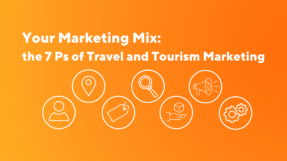
Branding can be time-consuming and costly, so isn’t something a lot of small and medium-sized tour and activity business are willing to devote resources to. But with the right techniques and methods, you can build a brand that will bring you value that far outweighs the costs.
The Importance of Branding Your Tour Business
What kind of value can branding bring to your tour or activity business?
1. Brands Define Identity
Brands can visually, verbally, and physically define your tour or activity business’ identity.
Visually: A logo is one of the main visual tools that can help your audience identify your brand. Think of how easily people everywhere recognize the Coca-Cola logo.
Verbally: Tone of voice, a tag-line, or even presence on social media can help define a brand’s voice. Take candy company Sour Patch Kids (SPK) using Snapchat to show off their fun-loving side. SPK teamed up with comedian Logan Paul who spent 5 days pulling pranks on people around New York city.
Physically: Every interaction a person has with your brand reflects your personality, whether this means interacting with an employee or your website. Lululemon, an active-wear brand, trains all retail employees to be extra-friendly with customers to show-off their customer-oriented identity.
2. Brands Give a Competitive Advantage
Brands are a valuable source of a competitive advantage:
- Brands hold value to customers.
- Brands take time and money to build.
- Brands are difficult to replicate.
Example- H&M
Market responsiveness is an example of a brand differentiator that creates a competitive advantage.
H&M is known as a brand that gets quickly gets new looks from the runway and into their stores. In order to do so, H&M took the time and the money to build a large team of distributors, marketers, designers, and others.
This has given H&M a competitive advantage that cannot be easily replicated by brands that don’t have the same resources.
3. Brands Are an Asset
A customer will choose one brand over another for many reasons:
- Customers have a sense of loyalty to the brand
- Customers are emotionally invested in what the brand represents
- Customers know what to expect from the brand
Example- Apple
Apple is known for producing user-friendly, sleek, innovative, and expensive products. However, Apple sells more than just a computer. They sell a minimalist, artistic, innovative lifestyle that millions of people identify with.
This has produced die-hard customers who are so emotionally-invested in Apple that they would never think to use another brand.
4. Brands Set Expectations
Brands set expectations for customers and employees:
- Customers: Defining a clear brand gives customers an idea of what they can expect from you and your employees.
- Employees: Defining a clear brand helps to provide employees with motivation and direction.
Example – Google
Google is a brand known for being innovative and creative and their customers expect innovative and creative products and services from them. In order to generate such products and services, Google provides their employees with a work environment that reflects the same characteristics.
How To Define Your Brand
Before you start designing and creating logos, marketing channels, etc., it’s important to define an overall vision and direction for your brand.
Define:
- Who you are going to launch your brand for? Who is your target audience?
- What is your company’s mission? What are the benefits of your tour business? What qualities, values, and feelings you want associated with your brand?
- Why did you choose your brand’s image? Your image is important for your customers so that they can identify with your brand.
- When are you going to launch your brand?
- Where are you going to launch your brand?
- How are you going to communicate and deliver your brand’s image? What is your brand’s tone of voice? What is the best logo design?
Remember, that the process of defining your brand is complex and time-consuming so give yourself enough time to think every element through.
Elements That Make a Brand
A brand is composed of the following elements:
1. The Experience
The experience a person has with your brand involves everything from when they look up your website to when they’re on a tour.
All experiences a customer has with your brand should be consistent and positive.
2. Personality
The personality of your brand involves its ‘essence.’ Does your brand have a fun, funky outgoing personality or more of a quieter, conservative personality?
Personality should be reflected in tone of voice, design, and every other element of your brand.
Example – Dove
Dove has a purist personality that reflects wholesomeness, good-heartedness, ethical behavior, and purity.
Dove’s personality is reflected in their beauty campaigns.
3. Design
Logo: Your logo is the image that people will associate with your brand so choose carefully.
Colours: Colors evoke different emotions in people. You’ll want to choose color schemes that best describe your brand’s personality.
Read HelpScout’s article on The Psychology of Color in Marketing and Branding.
Fonts: Even the fonts that you choose will give people an idea of the personality of your brand.
4. Photography
Photography normally would go under design, but for tour or activity operators, photography is a key element of branding.
Potential customers cannot feel the services that a tour or activity business offers, customers instead have to see the kind of experiences they can have. For this reason, tour or activity operators should invest in high-quality photography that will really show-off their experiences.
Every tour brand should have these photos:
-
- Hero Photos: A single image on a website that will capture your audience’s attention.
- Activity Photos: Provide customers with a variety of pictures that show them what kinds of activities they can do on their tour.
- Unique Photos: Post photos that will make you stand out from the competition. What about your tour is going to give customers an extra special experience?
- Team Photos: Post pictures of your team to humanize your brand.
Example – Travel Noire
Travel Noire, a tour booking service, has an Instagram full of beautiful, high-quality images of the experiences they offer their clients.
View this post on Instagram
5. Interactions
Customer service is important in any service-based industry. Treat your customers the way that you want your brand’s name to be treated.
Word-of-mouth is one of the largest channels that people discover brands. If you provide your customers with a great experience, then they will become advocates for your brand.
Example – Sony
Sony wants all their customers’ interactions with their brand to be pleasant, easy and worry-free.
How does Sony’s line up their branding strategy to reflect pleasant interactions?
Sony has over 3,500 customer service centers around the world so that customers can get the help they need whenever and wherever!
Sony also designs their products and services to be user-friendly so that customers are less likely to have to use the customer service support.
As a tour or activity business, you can achieve the same pleasant interactions by creating a brand strategy that is customer-focused.
Looking to design a great booking experience for your customers? Use Rezgo’s booking software that features a professionally designed responsive website and software support to ensure that every interaction with your brand is pleasant.
4 Tips For Building A Successful Brand For Your Tour Business
Why create just any brand when you can create a brand that is known and loved by all? Follow these 4 tips to build a successful brand for your tour or activity business.
1. Be Original
Replicating a big brand’s strategy:
- Comes across as inauthentic.
- Is difficult to do because big brands invest a lot of time, energy and money into creating a brand that cannot be easily replicated.
Spend the time to build your own unique look, voice, and feel so that you will stand out in your audience’s mind.
2. Be Consistent
Provide your customers with the same type of experience, personality, and design, so that customers aren’t surprised when they have an interaction with your brand. Consistency will result in customer loyalty.
I.e. Apple customers expect the brand to consistently deliver sleek, innovative products.
3. Be a Community
Big companies like Google and Facebook understand the importance of communities for their brand’s name. Community networks spread far and wide and with a good word put in for your brand, you can build a strong reputation without much effort.
Small tour and activity businesses can work on building their own community by taking advantage of social networks like Facebook and Instagram.
4.Be Valuable
In order to entice your customer to choose your brand over another, you have to deliver unique value that cannot be replicated.
This means more than just offering the lowest price; Toms Shoes, for example, doesn’t offer the lowest price or the most well-designed shoes, but they do shine when it comes to social responsibility. Toms’ gives a pair of shoes to a disadvantaged child every time someone makes a purchase.
Toms’ provides value to their customers by giving them a chance to be socially responsible.
Wrap It Up
To wrap it up, here is what developing a brand will do for your tour or activity business:
- Branding will help you develop better customer relationships
- Branding will give you a deeper understanding of your customers desires and needs
- Branding will help increase sales, conversions, leads, reach and engagement
- Branding will help deliver a consistent message and identity to your customers and employees
Are you looking to develop a brand and save some $$$? Check out our 4-step guide to branding on a budget!





